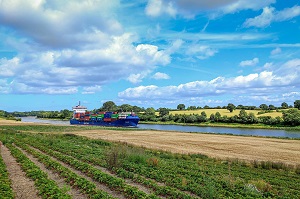![]() Global Supply Chain Dependence is a news and information topic monitored and covered by: Prepper Watch – Food Concerns
Global Supply Chain Dependence is a news and information topic monitored and covered by: Prepper Watch – Food Concerns
Introduction
In a world increasingly interconnected by global trade, many countries depend heavily on imported crops for food security. From grains like wheat and rice to fruits and vegetables, many of the crops that sustain populations are grown far from their final destinations.
This dependence on global supply chains makes nations vulnerable to disruptions, including trade conflicts, political instability, natural disasters, and pandemics. For preppers, understanding these vulnerabilities and preparing accordingly is essential to ensure food security and resilience in the face of such disruptions.
This blog will delve into the challenges posed by global supply chain dependence for key crops and how preppers can take proactive measures to safeguard their food resources. We’ll explore the potential risks, strategies for preparedness, and actionable steps that can be taken to reduce reliance on external sources.
Understanding Global Supply Chain Dependence for Key Crops
The global food supply chain is a complex web that involves farmers, processors, transporters, wholesalers, and retailers. The dependence on imported crops is especially evident in nations that cannot grow certain staples due to climate, soil conditions, or land availability. For example:
- Wheat: A key crop for bread, pasta, and other staple foods, wheat is produced mainly in countries like Russia, the United States, Canada, and Australia. A disruption in any of these regions due to natural disasters, political instability, or supply chain failures can cause wheat shortages globally.
- Rice: Asia accounts for around 90% of the world’s rice production. Countries like China, India, and Thailand are key exporters. A disruption in these regions can create a domino effect on global rice prices, impacting millions of people who rely on this grain for their primary source of calories.
- Fruits and Vegetables: Many nations rely on imported produce from countries with favorable climates for growing crops year-round, such as Mexico, Chile, and Spain. A trade war, tariffs, or poor harvests can lead to shortages of fresh produce, raising food prices and causing nutritional deficiencies.
- Soybeans: As a primary source of protein in many diets and an essential ingredient in animal feed, soybeans are often imported from countries like Brazil and the U.S. A disruption in these regions could cripple the agricultural industry in nations that depend on soybeans for food and animal production.
Understanding these vulnerabilities is key for preppers who are looking to ensure they can maintain a stable food supply even when these crops are unavailable or unaffordable due to supply chain failures.
Potential Risks of Global Supply Chain Disruptions
Several risks make global supply chains for key crops fragile:
- Trade Conflicts and Tariffs: International trade agreements are subject to change, especially during times of political tension. Trade wars, such as those seen between the U.S. and China in recent years, can severely disrupt the flow of crops between nations. Tariffs on imported crops make them more expensive and can even lead to supply shortages if countries turn to alternative sources.
- Political Instability: Civil unrest, coups, or changes in leadership in major crop-producing nations can destabilize the global supply chain. For instance, agricultural exports from countries like Venezuela have been disrupted by political upheaval, affecting global access to crops like corn and oilseeds.
- Natural Disasters: Hurricanes, floods, droughts, and wildfires can damage large swathes of farmland, particularly in key growing regions. Climate change has made these events more frequent and severe, threatening global crop production. A natural disaster affecting a major exporter like the U.S. Midwest, for example, can have global repercussions.
- Pandemics: The COVID-19 pandemic highlighted the vulnerabilities of global food systems. Factory shutdowns, transportation delays, and labor shortages disrupted the production and distribution of crops around the world. Even after the immediate impact subsides, the aftereffects can continue to affect food prices and availability.
- Logistical Failures: The COVID-19 crisis also exposed the fragility of the transportation sector. Shipping delays, container shortages, and disruptions to air and sea freight can result in shortages of essential crops.
How Preppers Can Prepare for Crop Supply Disruptions
Preppers can take various steps to mitigate the risks of global supply chain dependence and ensure food security in the face of crop shortages. Here are some key strategies for preparing:
- Stockpiling Non-Perishable Foods
One of the easiest and most immediate steps is to build a food storage plan. Stockpiling non-perishable foods that don’t rely on global supply chains is crucial. Items like rice, beans, canned vegetables, and freeze-dried fruits can provide sustenance for months or even years.
- Tip: Aim to store a six-month to one-year supply of essential food items that are resistant to shelf-life issues. Rotate stock to ensure you use older products first, keeping your stock fresh.
- Diversify Food Sources
Relying on a narrow range of food sources can be a significant vulnerability. Preppers should aim to diversify their food sources both by type and origin. This could involve growing a variety of crops, investing in alternative protein sources like beans or quinoa, and learning how to preserve food through canning, drying, and fermentation.
- Tip: Diversifying your food production with seasonal crops and perennials can help ensure year-round food security. Consider growing crops that are adaptable to various climates, like potatoes, squash, and herbs.
- Learn to Grow Your Own Food
One of the most reliable ways to reduce dependence on global supply chains is to become more self-sufficient in food production. Learning how to grow fruits, vegetables, and herbs in your own garden can provide an immediate solution to crop shortages. Consider starting with easy-to-grow crops like tomatoes, lettuce, and carrots.
- Tip: Invest in raised garden beds or container gardening systems for smaller spaces. If you have limited land, vertical gardening and hydroponics are excellent alternatives.
- Raise Livestock and Bees
Raising livestock, such as chickens, goats, or rabbits, can supplement your food supply with eggs, meat, and milk. Bees are also essential for pollination, and beekeeping can provide honey, which is a valuable source of nutrition and an excellent long-term preservative.
- Tip: Ensure that you have enough space, resources, and knowledge to care for livestock and bees. Livestock care requires consistent attention and investment.
- Develop Food Preservation Skills
Preserving food through canning, freezing, and drying is essential for long-term food security. These methods ensure that you can store seasonal crops for use when they are no longer in season or when imports are unavailable.
- Tip: Start by learning the basics of home canning. Investing in a pressure canner and jars can help you store a variety of foods. Dehydrators are also an excellent tool for preserving fruits and vegetables.
- Establish Local and Regional Food Networks
Relying solely on global supply chains leaves you vulnerable to international disruptions. Preppers can reduce this risk by building relationships with local farmers, food co-ops, or community-supported agriculture (CSA) programs. This network of local producers can provide food in times of global supply chain failure.
- Tip: Join a local CSA or barter with neighbors who grow their own food. By fostering these relationships, you can increase your access to fresh, locally grown produce and reduce your reliance on imported crops.
- Prepare for Bartering and Alternative Currencies
In the event of a collapse of global supply chains, currencies may become volatile or lose value entirely. Preppers should be ready to barter for goods and services. Consider storing valuable trade goods, such as salt, tools, alcohol, and medicine, which can be used to exchange for food or other essential items.
- Tip: Build a barter kit with useful items that are likely to have value in a crisis. This can include food, supplies, and skills.
- Invest in Backup Systems
Having backup systems in place for power generation (e.g., solar panels), water filtration (e.g., Berkey filters), and food storage (e.g., root cellars or food vaults) is essential for long-term resilience. A solar-powered freezer can keep your preserved food cold, and a backup water filtration system ensures you always have access to safe drinking water.
- Tip: Invest in renewable energy systems to reduce reliance on external sources for power. Solar power, wind turbines, and small-scale hydropower systems can provide a sustainable solution.
Conclusion
As the world continues to face the challenges of globalization and interconnectedness, the risks associated with global supply chain dependence for key crops will only grow. For preppers, understanding these risks and taking proactive steps to prepare is essential to maintaining food security and independence. By diversifying food sources, learning to grow and preserve food, and building resilient networks, preppers can ensure that they are ready for whatever disruptions may come their way.
In an era where political instability, climate change, and economic uncertainty are all on the rise, the ability to rely on local and personal food sources is not just a luxury—it’s a necessity. As a prepper, you must adapt and evolve, ensuring that you are not dependent on global systems that may fail when you need them most.

